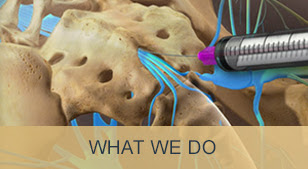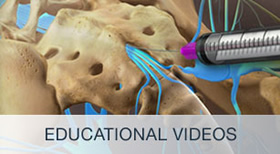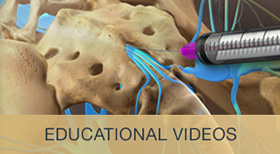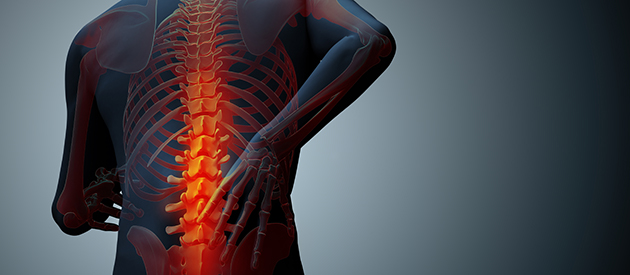Radiofrequency Ablation/Lesioning
Lumbar Radiofrequency Ablation
Lumbar Radiofrequency Ablation also known as Rhizotomy or neurolytic lesioning, is a minimally invasive procedure for treating lower back, buttocks, hip, and posterior thigh pain. It is used primarily for treating back pain originating in the lumbar facet joints.
Thoracic Radiofrequency Ablation
Thoracic Radiofrequency Ablation is a minimally invasive procedure for treating thoracic (mid back) pain.
Cervical Radiofrequency Ablation
Cervical Radiofrequency Ablation is a minimally invasive procedure for treating pain in the neck, posterior scalp, shoulder, shoulder blade, and arm.
What is Radiofrequency Nerve Ablation?
Radiofrequency ablation is a simple treatment that utilizes high frequency energy and heat to damage the small nerves of the facet joints. The Radiofrequency lesioning is done through a small needle under x-ray.
Why is radiofrequency nerve ablation performed on the spine?
The spinal facet joints can become very painful from injury,inflammation, and arthritis. Prior to nerve ablation you will have therapeutic facet joint blocks. If you have only short term relief, you are a candidate for radiofrequency. Doctors use radiofrequency nerve ablation to destroy the nerves' ability to transmit pain signals to the spine and brain, effectively anesthetizing the facet joint for long periods of time. This allows the patient to enjoy significant pain relief without the need for medication.
Are all of the nerves destroyed during this procedure?
The pinpoint accuracy of radiofrequency nerve ablation allows the doctor to remove only the nerves that transmit pain, eliminating damage to nearby nerves.
Are the results of this procedure permanent?
This procedure is not always permanent, as the nerves may slowly grow back over a period of approximately six months to several years. However, the procedure can be repeated as needed, often producing similar results. A rehabilitation program encompassing muscle strengthening and range of motion exercises may be advised for patients after the ablation procedure. This will help reduce the pain around the joints, especially if the nerves start to grow back.
How does it work?
The procedure is done in an outpatient facility in an OR. The patient will be sedated with intravenous (IV) medication before the insertion of the needles at each facet joint. Only one side is lesioned per session. While you are asleep, a needle will be inserted at the proper facet joints, with X-ray guidance. X-ray can only show bone, not small nerve branchs. You will then be awakened. Next, a microelectrode is threaded through the hollow inside of the needle. A small amount of electricity will then pass through the needle. The needle will be repositioned until you feel moderate pain. This is the "HOT SPOT". This pain will only last for several seconds. In order to lesion only the small nerve branch, not the larger nerve, you will be asked if your arm or leg is moving. If they are NOT moving, the lesioning can proceed. A radiofrequency current is sent through the needle for approximately 90 seconds, after which the needle is removed. This process is repeated until all affected facets joints have been targeted. It will take several days to 4 weeks to work and have significant pain relief. There is a good chance the procedure will work but it does not always work for various reasons.
What is the recovery like for this procedure?
After the surgery, you will be sent home once you are in stable condition, and may be given medication to relieve pain. You must limit your physical activity for at least 12 hours. You may return to work the next day. The injection sites may be painful for the first week after surgery, and may swell and/or bruise. This is normal, but if more severe symptoms occur contact your doctor.
What are some of the risks involved?
All l procedures carry some degree of risk, no matter how minimally invasive they are. Although complications are rare, they do have the potential to happen. Some of the more recognized complications are:
- Infection
- Allergic reaction
- Numbness
- Return of pain
- Neuromas and neuritis
All of these are protected against by your doctor's care and meticulous approach to your condition, but in some cases they are unavoidable. It is important you discuss these risks with your doctor before undergoing the operation.
For more information about Treatments, or to schedule an appointment, please call 484.468.1480.













